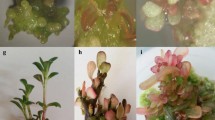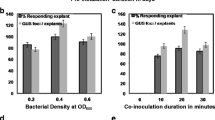Abstract
Rose-scented geranium is an important aromatic herb, have eminent for oil. The oil of geranium commercially utilized in the perfumery, cosmetic and aromatherapy industries all over the world. It is also helpful to cure many of the diseases, since it possess antibacterial, antifungal, antioxidant, anti-inflammatory and anticancer activities. However rose scented geranium suffer from several biotic and abiotic stresses, which reduced the yield of oil. So there is need to genetically improve the geranium using biotechnological approaches. The present study demonstrates the establishment of direct regeneration and Agrobacterium tumefaciens (LBA4404) mediated transformation protocol in Pelargonium graveolens (cv. CIM-BIO 171). Different media combinations such as benzyl amino purine (BAP), kinetin, naphthalene acetic acid (NAA), and adenine di-sulphate (ADS) were standardised to induce direct regeneration in P. graveolens. The maximum regeneration frequency i.e. 90.56 ± 1.2% per explant was achieved from petiolar segments in medium containing 2.5 mg/l BAP, 0.1 mg/l NAA, 1 mg/l ADS. However, with the leaf explants only 45.94 ± 2.91% frequency was achieved. In the present study, A. tumefaciens strain LBA4404 was used carrying binary vector pBI121 with the gusA as a reporter gene and neomycin phosphotransferase II (nptII) gene as a plant selectable marker. Parameters like bacterial optical density, infection time, acetosyringone concentration and kanamycin concentration were optimised to achieve maximum transformation frequency (69.5 ± 2.3%).The putative transgenic shoots were subsequently rooted on half strength MS medium and successfully transferred to the greenhouse. The transgenic plants were characterised by gus histochemical assay, PCR analysis (nptII-786 bp and gus A- 1707 bp) and Southern hybridization tests using gusA gene probe. The regeneration as well as transformation protocol will no doubt provide the basis to decipher the insights of metabolic pathways in geranium. Also could be useful for genetic improvement, to make it more tolerant/resistant against biotic and abiotic stresses and ultimately fruitful for Indian farmers in agronomic traits like high biomass, oil content, yield and better quality.








Similar content being viewed by others
Abbreviations
- MS:
-
Murashige and skoog
- BAP:
-
Benzylaminopurine
- NAA:
-
Naphthalene acetic acid
- IBA:
-
Indole-3-butyric acid
- ADS:
-
Adenine di-sulphate
- gusA:
-
β-Glucuronidase
- nptII :
-
Neomycin phosphotransferase
- X-Gluc:
-
5-Bromo-4-chloro-3-indolyl-β- D-glucuronide
References
Benazir JF, Suganthi R, Chandrika P, Mathithumilan B (2013) In vitro regeneration and transformation studies on Pelargonium graveolens (geranium)—an important medicinal and aromatic plant. J Med Chem Plant Res 7(38):2815–2822
Bigos M, Wasiela M, Kalemba D, Sienkiewicz M (2012) Antimicrobial activity of geranium oil against clinical strains of Staphylococcus aureus. Molecules 17:10276–10291
Boukhatem H, Djouadi L, Abdelaziz N, Khalaf H (2013) Synthesis, characterization and photocatalytic activity of CdS–montmorillonite nanocomposites. Appl Clay Sci 72:44–48
Chandel SCR, Pandey SK (2014) Effect of N6-benzylaminopurine and adenine sulphate in In-vitro plant regeneration of Phaseolus vulgaris L. Int J Curr Microbiol App Sci 3(12):801–806
Colby SM, Meredith CP (1990) Kanamycin sensitivity of cultured tissues of Vitis. Plant Cell Rep 9:237–240
Dorman HJD, Surai P, Deans SD (2000) In vitro antioxidant activity of a number of plant essential oils and phytoconstituents. J Essent Oil Res 12(2):241–248
Dutt M, Grosser W (2009) Evaluation of parameters affecting Agrobacterium-mediated transformation of citrus. Plant Cell Tiss Organ Cult 98:331–340
Fayed SA (2009) Antioxidant and anticancer activities of Citrus reticulate (Petitgrain Mandarin) and Pelargonium graveolens (Geranium) essential oils. Res J Agric Biol Sci 5:740–747
Fienberg AP, Vogelstein B (1983). A technique for radiolabeling DNA restriction endonuclease fragments to high specific activity. Ann Biochem 132(1):6–13
Gabriela V (2011) Effect of adenine sulfate (ADSO4) on the in vitro evolution of white clover variety (Trifolium repens L.). Analele Universităţii din Oradea, Fascicula Protecţia Mediului 17:203–210
Gnasekaran P, Antony JJJ, Jasim U, Sreeramanan S (2014) Agrobacterium-mediated transformation of the recalcitrant Vanda Kasem’s delight orchid with higher efficiency. Sci World J. http://dx.doi.org/10.1155/583934
Gupta V, Rahman LU (2014) An efficient plant regeneration and Agrobacterium-mediated genetic transformation of Tagetes erecta. Protoplasma. http://dx.doi.org/10.1007/s00709-014-0740-y
Gupta R, Banerjee S, Mallavarapu GR, Sharma S, Khanuja SPS, Shasany AK, Kumar S (2002) Development of a superior somaclone of rose-scented geranium and a protocol for inducing variants. Hortscience 37(4):632–636
Hassanein A, Chevreau E, Dorion N (2005) Highly efficient transformation of zonal (Pelargonium x hortorum) and scented (P. capitatum) geraniums via Agrobacterium tumefaciens using leaf discs. Plant Sci 169:532–541
Jefferson RA (1987) Assaying chimeric genes in plants: the gus gene fusionsystem. Plant Mol Biol Rep 5:387–405
Khan MK, Misra P, Sharma T, Shukla PK, Ramteke PW (2014) Effect of adenine sulphate on in vitro mass propagation of Stevia rebaudiana Bertoni. J Med Plant Res 8(13):543–549
Khan S, Fahim N, Singh P, Rahman LU (2015) Agrobacterium tumefaciens mediated genetic transformation of Ocimum gratissimum: a medicinally important crop. Ind Crops Prod 71:138–146
Kohli A, Miro B, Twyman RM (2010) Transgenic integration, expression and stability in plants: Strategies for improvements. In: Kole C, Michler CH, Abbott AG, Hall TC (eds) Transgenic crop plants: principles and development. Springer, Berlin pp 201–237
Krishna Raj S, Bi YM, Saxena PK (1997) Somatic embryogenesis and Agrobacterium-mediated transformation system for scented geraniums (Pelargonium sp. `Frensham’). Planta 201:434–440
Kumar S, Bhat V (2012) High-frequency direct plant regeneration via multiple shoot induction in the apomictic forage grass Cenchrus ciliaris L. In Vitro Cell Dev Biol Plant 48(2):241–248
Kumar V, Moyo M, Van Staden J (2015) Somatic embryogenesis of Pelargonium sidoides DC. Plant Cell Tiss Organ Cult 121:571. doi:10.1007/s11240-015-0726-2
Manfroi E, Yamazaki-Lau E, Grando MF, Roesler EA (2015) Acetosyringone, pH and temperature effects on transient genetic transformation of immature embryos of Brazilian wheat genotypes by Agrobacterium tumefaciens. Genet Mol Biol 38(4):470–476
Ming OC, Wen AS, Sinniah U, Xavier R, Sudramaniam S (2007) Cysteine and acetosyringone are the two important parameters in Agrobacterium mediated transformation of rose hybrid (Rose hybrid L.) cv. Nikita. J Plant Sci 2(4):387–397
Mishra S, Sangwan RS, Bansal S, Sangwan NS (2013) Efficient genetic transformation of Withania coagulans (Stocks) Dunal mediated by Agrobacterium tumefaciens from leaf explants of in vitro multiple shoot culture. Protoplasma 250:451–458
Murashige T, Skoog F (1962) A revised medium for rapid growth and bioassays with tobacco tissue cultures. Physiol Plant 15:473–497
Naaz A, Shahzad A, Anis M (2014) Effect of adenine sulphate interaction on growth and development of shoot regeneration and inhibition of shoot tip necrosis under in vitro condition in adult syzygium cumini L.a multipurpose tree. Appl Biochem Biotechnol 173:90–102
Nameth ST, Daughtrey ML, Moorman GW, Sulzinski MA (1999) Bacterial blight of geranium: a history of diagnostic challenges. Plant Dis 83(3):204–212
Peterson A, Goto M, Machmuah SB, Roy BC, Sasaki M, Hirose T (2005) Extraction of essential oil from Geranium (Pelargonium graveolens) with supercritical carbon dioxide. J Chem Technol Biotechnol 81:167–172
Ribas AF, Dechamp E, Champion A, Bertrand B, Combes MC, Verdeil JL, Lapeyre F, Lashermes P, Etienne H (2011) Agrobacterium-mediated genetic transformation of Coffea arabica (L.) is greatly enhanced by using establishedembryogenic callus cultures. BMC Plant Biol. doi:10.1186/1471-2229-11-92
Saini R, Jaiwal PK (2007) Agrobacterium tumefaciens- mediated transformation of blackgram: an assessment of factors influencing the efficacy of uidA gene transfer. Biol Plant 51(1):69–74
Sambrook J, Fritsch EF, Maniatis T (1989) Molecular cloning: a laboratory manual, 2nd edn. Cold Spring Harbor Press, NY p 2.60–2.80
Saxena G, Banerjee S, Rahman L, Mallavarapu GR, Sharma S, Kumar S (2000) An efficient in vitro procedure for micropropagation and generation of somaclones of rose scented Pelargonium. Plant Sci 155:133–140
Sharopov FS, Zhang H, Setzer WN (2014) Composition of geranium (Pelargonium graveolens) essential oil from Tajikistan. Am J Essential Oils Nat Prod 2(2):13–16
Shawl AS, Kumar T, Chishiti N, Shabir S (2006) Cultivation of rose scented geranium (Pelargonium sp.) as a cash crop in Kashmir Valley. Asian J Plant Sci 5(4):673–675
Shokri H, Khosravi AR, Mansouri M, Ziglari T (2011) Effects of zataria multiflora and geranium pelargonium essential oils on growth-inhibiting of some toxigenic fungi. Iran J Vet Res 12(3):247–251
Subramanyam K, Rajesh M, Jaganath B, Vasuki A, Theboral J, Elayaraja D, Karthik S, Manickavasagam M, Ganapathi A (2013) Assessment of factors influencing the agrobacterium mediated in planta seed transformation of brinjal (Solanum melongena L.). Appl Biochem Biotechnol 171:450–468
Twyman RM, Kohli A, Stoger E, Christou P (2002) Foreign DNA: integration and expression in transgenic plants. Genetic engineering. Setlow JK (ed) vol 24. Springer, New York, p 107–136
Verma RK, Yadav A, Verma RS, Rahman LU, Khan K (2013) Intercropping of aromatic crop Geranium pelargonium with Solanum tubersum for better productivity and soil health. J Environ Biol 35:1165–1171
Williamson JD, Desai A, Krasnyanski SF et al (2013) Overexpression of mannitol dehydrogenase in zonal geranium confers increased resistance to the mannitol secreting fungal pathogen Botrytis cinerea. Plant Cell Tiss Organ Cult 115:367. doi:10.1007/s11240-013-0368-1
Yadav SK, Katikala S, Yellisetty V, Kannepalle A, Narayana JL, Maddi V, Mandapaka M, Shanker AK, Bandi V, Bharadwaja KP (2012) Optimization of Agrobacterium mediated genetic transformation of cotyledonary node explants of Vigna radiate. SpringerPlus http://www.springerplus.com/content/1/1/59
Zhou J, Ma G, Bunn E, Zhang X (2007) In Vitro shoot organogenesis from Pelargonium Citrosum vanleenii leaf and petiole explants. Floriculture Orna Biotech 1(2):147–149
Zhu Q, Wu F, Ding F, Ye D, Chen Y, Li Y (2009) Agrobacterium-mediated transformation of Dioscorea zingiberensis Wright, an important pharmaceutical crop. Plant Cell Tissue Organ Cult 96:317–324
Zuraida AR, Mohd SMA, Ayu Nazreena O, Zamri Z (2013) Improved micropropagation of biopesticidal plant, Pelargonium radula via direct shoot regeneration. Am J Res Commun 1(1):1–12
Acknowledgements
The authors are thankful to the Director CSIR-CIMAP for providing necessary facilities to carrying out the research work and Dr. Ajay Kohli for editing the Manuscript. The first author also gratefully acknowledges CSIR Network Project ChemBio (BSC 203) for providing financial support.
Author information
Authors and Affiliations
Corresponding author
Electronic supplementary material
Below is the link to the electronic supplementary material.
Rights and permissions
About this article
Cite this article
Singh, P., Khan, S., Kumar, S. et al. Establishment of an efficient Agrobacterium-mediated genetic transformation system in Pelargonium graveolens: an important aromatic plant. Plant Cell Tiss Organ Cult 129, 35–44 (2017). https://doi.org/10.1007/s11240-016-1153-8
Received:
Accepted:
Published:
Issue Date:
DOI: https://doi.org/10.1007/s11240-016-1153-8




